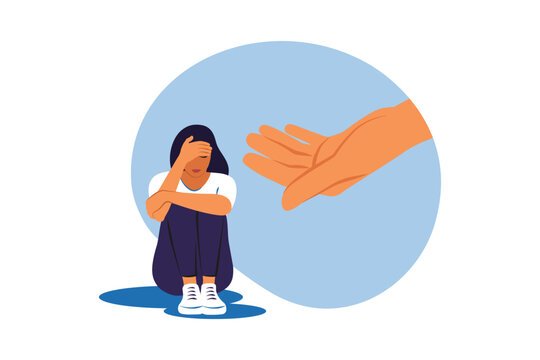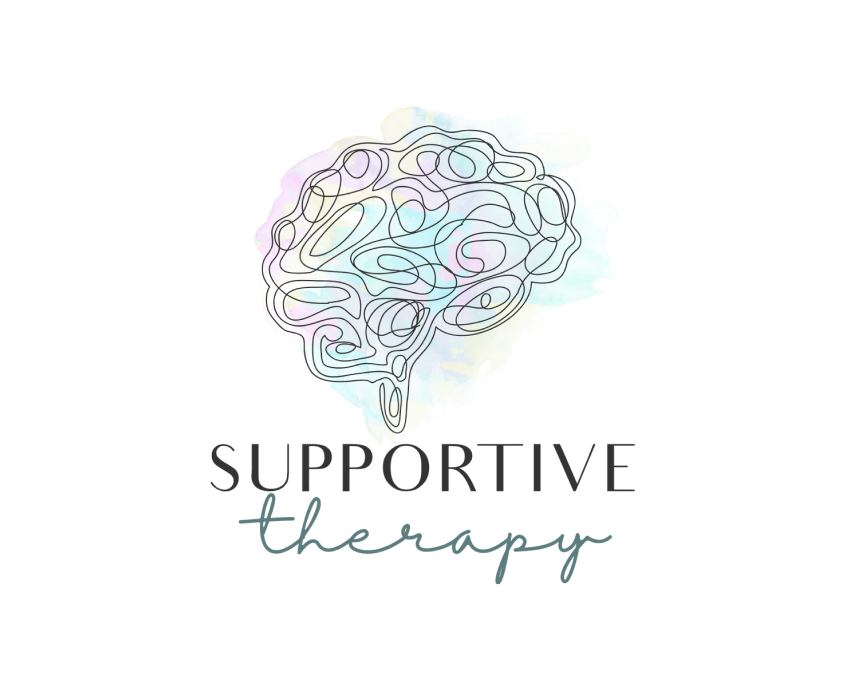Home » The Complete Guide to CBT » Cognitive Behavioural Therapy for Depression (CBT)
Cognitive Behavioural Therapy for Depression (CBT).
Gain a deeper understanding of depression and how CBT can help transform negative thought patterns into positive ones.

How Depression Works (Beck's Cognitive Model)
Beck’s Cognitive Model of Depression suggests that negative, distorted thought patterns are the root cause of depression. Individuals with depression tend to interpret life events through a negative lens, reinforcing persistent, harmful beliefs about themselves, the world, and the future.
According to Beck’s Negative Cognitive Triad, the three main dysfunctional beliefs of those with depression are:
- Negative views about themselves (“I am inadequate” or “I am worthless”).
- Negative views about the world (“No one values me” or “My experiences result in failures”).
- Negative views about the future (“The future is hopeless” or “Things can only get worse”).
CBT techniques focus on identifying and transforming these negative patterns through cognitive restructuring, helping patients replace them with more adaptive, positive thoughts.
Common Symptoms of Depression
While depression symptoms can be complex and vary from person to person, some of the most common signs can include:
- Persistent, unexplained sadness
- Constant negative thoughts about self, the world, and the future
- Feelings of guilt or worthlessness
- Irritability, anger outbursts, or frustration
- Changes in appetite and weight (loss or gain)
- Low energy and fatigue
- Anxiety, restlessness, or agitation
- Withdrawal from friends, hobbies, and interests
- Difficulty with thinking, decision-making, concentration, or memory
- Sleep disturbances (difficulty falling asleep or staying awake)
- Unexplained physical aches and pains
- Decreased libido
- In severe cases, thoughts of self-harm or suicide
It’s important to note that experiencing some of these symptoms doesn’t necessarily indicate clinical or terminal depression. Each individual’s mental health is unique, and symptoms can manifest in varying degrees. Seeking professional guidance from a healthcare provider is essential for an accurate diagnosis and proper care.
Early intervention and support can be pivotal in managing and improving one’s mental health, ensuring a tailored approach to treatment that addresses specific needs and challenges.
How Does CBT Treatment Help Depression?
According to Beck’s Cognitive Triad, negative views of oneself lead to negative views of the future, which in turn foster negative views of the world, perpetuating a cycle of depression.
According to Beck’s Cognitive Triad, negative views of oneself lead to negative views of the future, which in turn foster negative views of the world, perpetuating a cycle of depression. Cognitive Behavioral Therapy (CBT) aims to disrupt this cycle by helping patients identify and change these destructive thought patterns. Through techniques like cognitive restructuring, therapists assist individuals in challenging distortions such as overgeneralization and catastrophizing.
CBT is an effective strategy for depression, leading to a 53% reduction in symptoms.
Depressive Disorders Effectively Treated by CBT
1. Major Depressive Disorder (MDD)
MDD is marked by a persistent low mood and a loss of interest in once-enjoyed activities. Individuals often experience fatigue, feelings of worthlessness or guilt, trouble concentrating, and sleep disturbances, either insomnia or oversleeping.
2. Persistent Depressive Disorder (PDD)
PDD is a chronic form of depression lasting two years or more. It involves a prolonged sad or low mood, low self-esteem, fatigue, poor concentration, and difficulty sleeping.
3. Seasonal Affective Disorder (SAD)
SAD is triggered by seasonal changes, usually in fall and winter. Symptoms include persistent sadness, low energy, sleep difficulties, and increased appetite, often lasting several months.
4. Postpartum Depression (PPD)
PPD affects new mothers after childbirth, causing extreme sadness, fatigue, and feelings of guilt or worthlessness. Severe cases may involve thoughts of self-harm or harming the baby, often due to hormonal changes, stress, and lack of sleep.
5. Depressive episodes of bipolar disorder
Bipolar disorder involves alternating periods of depression and mania. During depressive episodes, individuals may feel sad, lose interest in activities, experience sleep and concentration issues, and struggle with feelings of worthlessness or suicidal thoughts.
6. Situational depression
Situational depression arises from traumatic or stressful life events, such as divorce or job loss. Symptoms include grief, hopelessness, anxiety, difficulty concentrating, and loss of interest in daily activities.
7. Schizoaffective disorder
A blend of schizophrenia and mood disorder symptoms, this condition includes depression, hallucinations, delusions, disorganized behavior, and difficulty functioning socially, often accompanied by depressive or manic episodes.
CBT Techniques to Help Treat Depression
1. Practicing Gratitude
Keeping a gratitude journal helps shift focus away from negativity by highlighting the positive aspects of life. This practice can neutralize negative emotions, fostering a sense of contentment and joy.
2. Pleasurable Activity Scheduling
Scheduling enjoyable activities encourages self-care and rewards oneself for engaging in positive experiences. This helps individuals stay motivated to complete tasks even when feeling low.
3. The ABC Belief Monitoring
The ABC model helps identify the relationship between triggering events, beliefs, and emotional or behavioral consequences. It allows individuals to break down and analyze negative patterns, making it easier to develop healthier responses. The model follows:
- Activating event
- Beliefs about the event
- Consequences of the event
4. Creating Stress-Free Environments
Utilizing breathing exercises, muscle relaxation, and guided imagery can help create a peaceful environment. Keeping spaces clean, organized, and comfortable also contributes to mental well-being and can alleviate feelings of depression.
5. Graded Exposure (breaking it down)
By breaking large tasks into smaller, manageable steps, individuals reduce feelings of overwhelm. Completing small goals builds confidence and makes it easier to handle larger tasks in the future, even during depressive episodes.
6. Meditation
Mindful meditation encourages individuals to stay grounded in the present moment and helps reduce the focus on negative thoughts. It allows individuals to detach from unhelpful thinking patterns and prevents them from becoming overwhelming.
7. Stop Catastrophic thinking
This involves identifying patterns of catastrophic thinking and reframing negative assumptions about reality. Individuals are taught to stop, recognize triggers, evaluate their automatic thoughts, and reframe their emotional responses into more realistic and helpful thoughts.
8. Behavioural Activation
Behavioral activation involves scheduling activities that promote even minimal physical activity, helping individuals fight inertia and feel purposeful. Using a calendar helps with decision-making and ensures consistency.
9. Schema Therapy
This integrative approach targets ingrained, unhelpful thoughts developed in childhood. Through cognitive, behavioral, and interpersonal interventions, schema therapy helps individuals transform dysfunctional life patterns that contribute to their depression.
CBT Methods for Depression
1. Acceptance and Commitment Therapy (ACT)
Acceptance and Commitment Therapy helps patients accept their depressive thoughts and emotions while engaging in helpful behaviours aligning with their personal goals. This approach empowers individuals to be more resilient in navigating the challenges of depression, reducing the overwhelming impact of negative thoughts and feelings.
2. Dialectical Behavioural Therapy (DBT)
Dialectical Behavioural Therapy helps patients develop self-supportive skills. It allows them to accept the aspects of their condition that cannot be changed and focus instead on the parts within their control. DBT teaches individuals both the skills for change and the skills for radical acceptance.
3. Rational Emotive Behaviour Therapy (REBT)
Rational emotive behaviour therapy helps patients recognize and rationally examine their depressive thoughts, replacing them with healthier, more positive beliefs. REBT is based on the principle that it’s not what happens to the individual that causes their problems but how they think about it.
4. Narrative Therapy
Narrative therapy helps patients understand themselves better by retelling their life story to a therapist, who helps them identify the main “problem story” they are repeatedly telling themselves. The therapist helps the patient get to the root of the problem story and find an alternative one to challenge it. In this process, patients can acknowledge their strengths and resources, facilitating necessary life changes.
How Specialized CBT Therapists Can Help
CBT for depression typically involves 12-20 weekly sessions between the patient and therapist, though many individuals notice improvements in mood and symptoms within a few weeks. Each session follows a structured format, which includes:
- Setting a goal or identifying a specific problem to address.
- Working through the problem during the session.
- Creating an action plan to alleviate the problem.
- Measuring progress on the issue.
During these sessions, the therapist helps the patient evaluate their negative thoughts and reactions to daily events. The patient learns to identify and challenge negative distortions, developing more realistic perspectives and healthier ways of thinking. Additionally, patients learn to recognize and change behaviors that contribute to their depression.
The primary objective of CBT for depression is to equip patients with healthier coping mechanisms for managing life’s challenges effectively.
Contact Us For a Free Consultation
Take the first step in overcoming depression by connecting with a therapist today. Our personalized approach is designed to empower you to regain control and create lasting, positive change in your life.
Frequently Asked Questions
The 3 C’s of CBT can help identify and evaluate unhelpful, inaccurate thinking. They are:
- Catch it: Catch the thought associated with a specific negative experience.
- Check it: Stop and reflect on how accurate and useful the thought is.
- Change it: Change the thought to a more accurate, helpful, and positive one.
Thinking traps are certain types of thoughts that trap individuals in anxiety. These can include catastrophizing (imagining the worst-case scenario), fortune telling (believing one can predict the future), and mind reading (believing one knows exactly what others are thinking).

